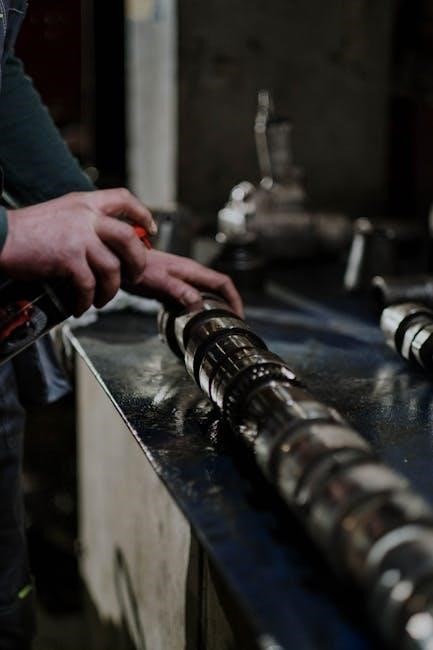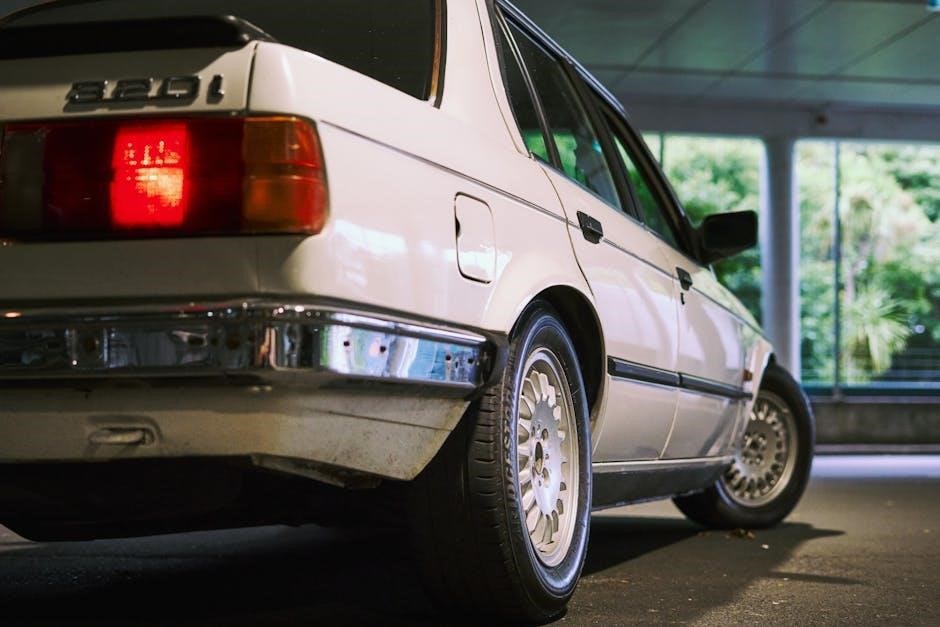The primary difference between automatic and manual transmissions lies in how gears are changed during driving. Automatic transmissions shift gears automatically‚ while manual transmissions require driver involvement. This distinction impacts driving experience‚ control‚ and convenience‚ making the choice between them a key decision for drivers.
1.1 Overview of Automatic Transmission
An automatic transmission shifts gears without driver input‚ using a complex system of sensors and hydraulic controls. It eliminates the need for a clutch pedal‚ providing ease of use and smooth acceleration. The torque converter plays a central role‚ connecting and disconnecting engine power during gear changes; This setup reduces driver effort‚ especially in traffic‚ making it ideal for urban driving and those prioritizing convenience over manual control.
1.2 Overview of Manual Transmission
A manual transmission requires the driver to actively shift gears using a clutch pedal and gearshift. This system offers precise control over acceleration and speed‚ often preferred by driving enthusiasts. The process involves pressing the clutch‚ selecting the appropriate gear‚ and releasing the clutch smoothly to maintain momentum. This mechanical interaction provides a direct connection to the vehicle‚ enhancing the driving experience and driver engagement compared to automatics.

How Manual Transmissions Work
Manual transmissions operate by requiring the driver to press the clutch pedal and use the gearshift to manually change gears. This process demands the driver’s active role in synchronizing clutch presses with gear selection‚ providing control over acceleration and speed.
2.1 The Role of the Clutch Pedal
The clutch pedal is essential in manual transmissions‚ as it disengages the engine from the transmission‚ allowing gear changes without grinding. Pressing the pedal fully disconnects engine power‚ enabling smooth shifts. Releasing it gradually reconnects power‚ ensuring control. This mechanism requires precise coordination between the pedal and gearshift‚ making it fundamental to manual driving.
2.2 Gear Shifting Process in Manual Cars
In manual cars‚ the gear shifting process involves pressing the clutch pedal‚ moving the gearstick to the desired gear‚ and slowly releasing the clutch while accelerating. This process requires coordination between the clutch‚ gearstick‚ and accelerator. Drivers must listen to engine sounds and feel the car’s response to shift smoothly. Proper technique prevents damage and ensures efficient power delivery‚ making it a skill that improves with practice and experience.
2.3 Driver Involvement in Manual Cars
Driving a manual car requires active engagement‚ as the driver must operate the clutch and gearstick to shift gears. This hands-on process demands attention and skill‚ making the driving experience more interactive. The driver feels connected to the vehicle‚ controlling acceleration and deceleration through precise gear changes. This involvement can enhance the joy of driving for enthusiasts but may feel less convenient for others who prefer a more relaxed experience behind the wheel.

How Automatic Transmissions Work
Automatic transmissions use a torque converter to automatically shift gears‚ eliminating the need for manual clutch operation. This system provides smooth‚ seamless acceleration without driver input.
3.1 Automatic Gear Shifting Mechanism
The automatic gear shifting mechanism relies on a torque converter to transfer engine power to the transmission. Sensors monitor driving conditions‚ such as speed and throttle position‚ to determine optimal gear shifts. The transmission control module processes this data to engage the appropriate gear ratio via hydraulic or electronic actuators. This system ensures smooth‚ seamless acceleration without driver input‚ utilizing a planetary gear set to provide multiple gear ratios efficiently.
3.2 The Role of a Torque Converter
The torque converter is a fluid-filled coupling that connects the engine to the automatic transmission. It substitutes for a manual transmission’s clutch‚ allowing the engine to continue running when the car is stationary. The torque converter multiplies torque during acceleration and ensures smooth power transfer between the engine and transmission. Its design enables seamless engagement and disengagement of power‚ eliminating the need for manual clutch operation and providing a comfortable driving experience.
3.4 Driver Convenience in Automatic Cars
Automatic cars offer greater convenience‚ as they eliminate the need for manual gear shifting. Drivers can focus solely on steering and braking‚ making city driving and heavy traffic less stressful. The absence of a clutch pedal simplifies operation‚ especially in stop-and-go situations or hilly terrain. This ease of use makes automatics ideal for new drivers or those prioritizing comfort and simplicity behind the wheel.
Key Differences: Driver Involvement
Manual cars demand higher driver engagement with clutch and gear shifts‚ offering more control. Automatics prioritize convenience‚ reducing driver input and effort‚ especially in traffic or hilly terrain;
4.1 Driver Engagement in Manual Cars
Manual cars require active driver engagement‚ as the driver must press the clutch and shift gears manually. This hands-on approach creates a direct connection to the vehicle‚ allowing for precise control over acceleration and deceleration. The constant interaction with the clutch and gearshift makes driving feel more engaging and rewarding‚ especially for enthusiasts who enjoy the tactile experience of driving. This level of involvement can enhance the overall driving experience for those who enjoy being fully connected to their car.
4.2 Driver Comfort in Automatic Cars
Automatic cars provide greater driver comfort by eliminating the need for manual shifting. The transmission handles gear changes seamlessly‚ reducing physical effort and mental focus. This makes driving less strenuous‚ especially in heavy traffic or hilly terrain. Automatics also simplify the learning process for new drivers‚ as they don’t need to coordinate clutch and gearshift actions‚ creating a more relaxed and enjoyable driving experience overall.

Key Differences: Ease of Use
Automatic cars offer greater ease of use‚ as they eliminate the need for manual gear shifting‚ making driving smoother and less physically demanding‚ especially in traffic.
5.1 Learning Curve for Manual Cars
Manual cars require a significant learning curve‚ as drivers must master the coordination of the clutch pedal‚ gearshift‚ and accelerator. This process demands practice to avoid stalling and ensure smooth transitions between gears. For new drivers‚ the initial difficulty can be frustrating‚ but many find the skill rewarding once mastered‚ offering greater control and connection with the vehicle.
5.2 Simplicity of Automatic Cars
Automatic cars offer unparalleled simplicity‚ eliminating the need for manual gear shifting. With only basic pedals and no clutch‚ drivers can focus solely on steering and braking. This ease of use makes automatic vehicles ideal for urban driving‚ heavy traffic‚ and newcomers to driving‚ providing a stress-free experience and reducing the learning curve significantly compared to manual transmissions.

Cost Considerations
Cost differences between automatic and manual transmissions are significant. Manual cars are generally cheaper to purchase and maintain‚ making them a budget-friendly option. Automatics‚ while more expensive upfront‚ offer greater convenience.
6.1 Purchase and Maintenance Costs of Manual Cars
Manual cars are typically more affordable to purchase and maintain compared to automatics. They have fewer complex components‚ reducing production and repair costs. Lower purchase prices and simpler mechanics make manual transmissions a cost-effective choice for budget-conscious drivers. Additionally‚ manual cars often experience lower maintenance expenses over time‚ contributing to long-term financial savings.
6.2 Purchase and Maintenance Costs of Automatic Cars
Automatic cars generally have higher purchase and maintenance costs than manual vehicles. The complex gear-shifting mechanism and torque converter increase production expenses. Repairs‚ especially for modern automatics with advanced technology‚ can be costly. However‚ the added convenience often justifies the expense for many drivers‚ making automatics a worthwhile investment for those prioritizing ease of use over cost savings.

Fuel Efficiency Comparison
Manual cars typically offer better fuel efficiency due to direct gear control‚ while automatics‚ especially older models‚ tend to use slightly more fuel in most driving conditions‚ though modern automatics have improved.
7.1 Fuel Efficiency of Manual Cars
Manual cars are generally more fuel-efficient than automatics‚ especially in city driving‚ due to better control over gear shifts and lower energy loss. The absence of a torque converter and the ability to keep engine RPMs low during acceleration contribute to this efficiency. While modern automatics have closed the gap‚ manuals still often edge ahead in fuel savings for experienced drivers who can optimize their shifting techniques effectively.
7.2 Fuel Efficiency of Automatic Cars
Automatic cars have improved significantly in fuel efficiency‚ especially with advancements like CVT and dual-clutch systems. While they typically consume slightly more fuel than manuals‚ modern automatics often match or even surpass manual transmissions in efficiency‚ depending on driving conditions. However‚ older automatic models generally lag behind manuals in fuel economy‚ making manual transmissions the traditional choice for better mileage in many cases.

Resale Value Differences
Manual cars often retain better resale value due to enthusiasts’ demand‚ while automatics are more common but may depreciate slightly faster in certain markets.
8.1 Resale Value of Manual Cars
Manual cars typically hold higher resale value‚ especially among enthusiasts‚ due to their unique driving experience and lower production volumes. Demand for manuals remains steady‚ particularly in performance or classic vehicles‚ as they often appeal to purists and collectors. This niche demand can result in better long-term value retention compared to automatic counterparts in certain markets.
8.2 Resale Value of Automatic Cars
Automatic cars generally have broader appeal due to their ease of use‚ making them more popular in the used car market. However‚ their resale value often trails behind manual counterparts‚ particularly for performance vehicles. Automatics may depreciate faster‚ especially as manual transmissions become less common‚ reducing their demand in niche markets but maintaining steady value in mainstream segments.

Driving Experience and Control
Manual transmissions offer greater driver control and engagement‚ while automatics provide ease and convenience‚ shaping distinctly different driving experiences based on personal preference and driving conditions.
9.1 Driving Control in Manual Cars
Manual cars provide drivers with precise control over gear shifts‚ allowing for better acceleration and deceleration. The clutch pedal and gearshift enable direct engagement with the vehicle‚ making driving feel more interactive. This control is particularly advantageous in situations like uphill driving or overtaking‚ where manual adjustments can enhance performance. The ability to manually select gears also fosters a stronger connection between the driver and the car‚ heightening the overall driving experience.
9.2 Driving Control in Automatic Cars
Automatic cars simplify driving by handling gear shifts without driver input‚ reducing the need for manual coordination. This design enhances comfort‚ especially in heavy traffic or long commutes‚ allowing drivers to focus on steering. While control over individual gears is limited‚ modern automatics often feature manual modes‚ blending convenience with optional driver engagement. The seamless operation of automatics makes them ideal for those prioritizing ease of use and stress-free driving experiences.
The choice between automatic and manual transmissions depends on personal preferences and driving conditions. Manuals offer control and efficiency‚ while automatics provide ease and convenience‚ making each suitable for different lifestyles and needs.
10.1 Final Thoughts on Manual vs. Automatic
Manual transmissions offer greater control and fuel efficiency‚ appealing to driving enthusiasts‚ while automatics provide ease and convenience‚ ideal for urban commutes. The choice depends on personal preference‚ driving conditions‚ and lifestyle. Manuals require skill and engagement‚ whereas automatics prioritize comfort and simplicity. Both options have their merits‚ making the decision subjective based on individual needs and priorities.